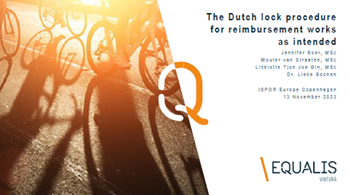The Dutch Lock Procedure for Reimbursement: Ensuring Effective and Affordable Healthcare
By AmerisourceBergen

A Thought Leadership Perspective on the Impact of the Lock Procedure


Inspiration behind the Research
The inspiration behind our research was twofold. First, we sought to understand how the lock procedure affected population health. Second, we aimed to analyze its impact on healthcare budgets through price negotiations and reallocation of budget towards other healthcare needs.
Key Takeaways
While it is essential to acknowledge that individual patients may experience delays in accessing new treatments, it is crucial to consider these findings from a broader societal perspective. The benefits derived from price negotiations outweigh the initial investment made during the lock procedure.
Surprisingly, our hypothesis was confirmed contrary to initial expectations. We anticipated more negative results regarding the lock procedure's effectiveness and cost-effectiveness. However, our research showcased that optimizing price negotiations leads to favorable outcomes for both population health and healthcare budgets.
What’s next?
During our research process, we encountered assumptions that influenced our national-level model's results. One area that warrants further examination is displacement modeling—the method used to determine how negotiated discounts on new drugs translate into quantifiable Quality Adjusted Life Years (QALYs) within the Dutch hospital setting.
While no unexpected findings emerged from this study specifically, it is worth noting that further research should focus on improving displacement modeling methods for more accurate assessments of cost savings and QALYs gained.
We recommend additional research initiatives focusing on three key areas:
- Quantifying displacement: Refine current displacement models and explore alternative approaches for accurately assessing cost savings and QALYs gained.
- Alternative routes of reimbursement for cost-effective drugs: Investigate novel reimbursement pathways that facilitate timely access while ensuring affordability.
- Assess the extent of financial arrangements for comparative routes: Gain insight in financial agreements within comparative routes of drug assessment.
Furthermore, beyond scientific investigation lies an essential policy discussion at a higher level regarding striking a balance between timely access and negotiation efforts within the lock procedure framework.
Our research demonstrates that despite potential delays in accessing new drugs due to the lock procedure, optimized price negotiations yield substantial benefits for population health and healthcare budgets alike. By redirecting funds saved through negotiation efforts towards other healthcare needs, we enhance overall health outcomes at a national level.
Our teams remain committed to driving positive change within the Dutch healthcare system, and globally, through data-driven insights and innovative solutions. Our collaboration with stakeholders such as the Dutch HealthCare Institute facilitates ongoing discussions surrounding policy enhancements related to drug reimbursement procedures like the lock procedure.
Together with industry partners across various sectors within healthcare, we strive towards an effective balance between accessibility and affordability—ensuring better patient outcomes while maintaining responsibility in delivering quality care.

Authors: Jennifer Boer, MSc; Wouter van Straaten, MSc; Liselotte Tjon Joe Gin, MSc; Dr. Lieke Boonen





